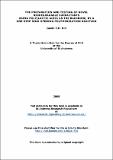The preparation and testing of novel biodegradable surfactants using poly(lactic acid) as the backbone, by a one-step ring opening polymerisation reaction
Abstract
A review of the chemistry of poly(lactic acid) was carried out with a focus on techniques and applications of PLA polymer and copolymers with reference to some of the work that has been accomplished over the last 20 years or so. A review of the characterisation techniques used to analyse PLA polymers and copolymers was also carried out giving reference to the equipment and methods used herein.
An investigation into the potential of PLA as the hydrophilic portion of a polymeric surfactant was carried out. To develop PLA based surfactants, the ring opening polymerisation of lactide was carried out in a melt in the presence of a long chain alcohol (C₇ to C₂₀) or diol (C₄ & C₆) to produce AB or ABA type polymers that follow the traditional surfactant template. Stannous octanoate and 4-dimethylaminopyridine were typically used as catalysts due to their high activity and relative cheapness. PLA only shows good hydrophilicity with up to 12 lactic acid units in the chain. Above this the electrostatic interactions between polymer chains reduced water solubility. It was also noted that D,L-lactide produced more water soluble polymers (syndiotactic) than the enantiomerically pure L-lactide (isotactic polymer chains).
An investigation of the hydrophobic properties of PLA was carried out to evaluate their usefulness for other biodegradable surfactant applications. To this end an investigation of sugars as the hydrophilic portion of the molecule was carried out. Due to problems with solubilising sugars, they were deemed unsuitable for use as initiatiors within the scope of this research.
Choline chloride was then investigated as a potential hydrophilic initiator and indeed has produced some of the most water soluble of PLA polymers. Choline chloride presented several challenges as an initiator, its high melting point resulted in polar solvents such as t-butanol being employed. Alternatively, more success was achieved by preparation of a choline chloride eutectic mixture prior to the polymerisation. It was discovered that a choline chloride/urea eutectic mixture was capable of self initiation, thus required no further addition of catalyst, this result shows a potential step forward in PLA green chemistry.
A final investigation into producing surface-active PLA in a one-pot process that required only a hydroxycarboxylate initiator was carried out. The production of PLA sodium or potassium salts was carried out in a melt polymerisation and the results show some promise. Initiators that have been employed include a range of a, b and g-hydroxycarboxylic acids. These work through tautomerisation to the alkoxide, which then initiates a living type polymerisation of lactide to produce surface-active polymers.
As well as the synthesis of these polymers some analysis of the physical and aqueous properties of these materials was carried out. PLA sodium salts were shown to have reasonable surfactant ability (~45 mNm⁻¹) and low CMC values of around 5x10⁻⁹ mol cm⁻³. They were also shown to have some properties as emulsifiers, and in some cases showed non-Newtonian fluid behaviour such as shear-thinning (thixotropy) and shear-thickening (dilatant). The thermal characteristics of the polymers such as T[subscript]g and stability were assessed as well as their ability to retain water.
Type
Thesis, PhD Doctor of Philosophy
Collections
Items in the St Andrews Research Repository are protected by copyright, with all rights reserved, unless otherwise indicated.

